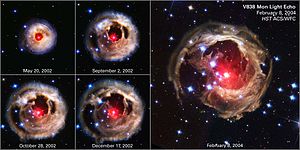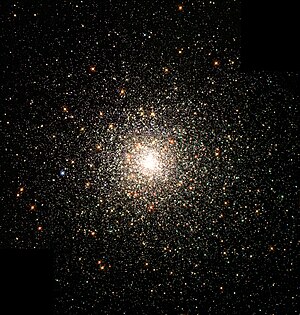Portal:Stars
IntroductionA star is a luminous spheroid of plasma held together by self-gravity. The nearest star to Earth is the Sun. Many other stars are visible to the naked eye at night; their immense distances from Earth make them appear as fixed points of light. The most prominent stars have been categorised into constellations and asterisms, and many of the brightest stars have proper names. Astronomers have assembled star catalogues that identify the known stars and provide standardized stellar designations. The observable universe contains an estimated 1022 to 1024 stars. Only about 4,000 of these stars are visible to the naked eye—all within the Milky Way galaxy. A star's life begins with the gravitational collapse of a gaseous nebula of material largely comprising hydrogen, helium, and trace heavier elements. Its total mass mainly determines its evolution and eventual fate. A star shines for most of its active life due to the thermonuclear fusion of hydrogen into helium in its core. This process releases energy that traverses the star's interior and radiates into outer space. At the end of a star's lifetime as a fusor, its core becomes a stellar remnant: a white dwarf, a neutron star, or—if it is sufficiently massive—a black hole. Stellar nucleosynthesis in stars or their remnants creates almost all naturally occurring chemical elements heavier than lithium. Stellar mass loss or supernova explosions return chemically enriched material to the interstellar medium. These elements are then recycled into new stars. Astronomers can determine stellar properties—including mass, age, metallicity (chemical composition), variability, distance, and motion through space—by carrying out observations of a star's apparent brightness, spectrum, and changes in its position in the sky over time. Stars can form orbital systems with other astronomical objects, as in planetary systems and star systems with two or more stars. When two such stars orbit closely, their gravitational interaction can significantly impact their evolution. Stars can form part of a much larger gravitationally bound structure, such as a star cluster or a galaxy. (Full article...) Selected star - Photo credit: Harvard-Smithsonian/NASA
Mira, /ˈmaɪrə/, also known as Omicron Ceti (or ο Ceti / ο Cet), is a red giant star estimated 200-400 light years away in the constellation Cetus. Mira is a binary star, consisting of the red giant Mira A along with Mira B. Mira A is also an oscillating variable star and was the first non-supernova variable star discovered, with the possible exception of Algol. Apart from the unusual Eta Carinae, Mira is the brightest periodic variable in the sky that is not visible to the naked eye for part of its cycle. Its distance is uncertain; pre-Hipparcos estimates centered around 220 light-years, while Hipparcos data suggests a distance of 418 light-years, albeit with a margin of error of ~14%. Evidence that the variability of Mira was known in ancient China, Babylon or Greece is at best only circumstantial. In 1638 Johannes Holwarda determined a period of the star's reappearances, eleven months; he is often credited with the discovery of Mira's variability. Johannes Hevelius was observing it at the same time and named it "Mira" (meaning "wonderful" or "astonishing," in Latin) in 1662's Historiola Mirae Stellae, for it acted like no other known star. Ismail Bouillaud then estimated its period at 333 days, less than one day off the modern value of 332 days (and perfectly forgivable, as Mira is known to vary slightly in period, and may even be slowly changing over time). The star is estimated to be a 6 billion year old red giant.
Selected article - Photo credit: NASA
A variable star can be classifies when its apparent magnitude as seen from Earth changes over time, whether the changes are due to variations in the star's actual luminosity, or to variations in the amount of the star's light that is blocked from reaching Earth. Many, possibly most, stars have at least some variation in luminosity: the energy output of our Sun, for example, varies by about 0.1% over an 11 year solar cycle, equivalent to a change of one thousandth of its magnitude. It is convenient to classify variable stars as belonging to one of two types:
The first variable star was identified in 1638 when Johannes Holwarda noticed that Omicron Ceti (later named Mira) pulsated in a cycle taking 11 months; the star had previously been described as a nova by David Fabricius in 1596. This discovery, combined with supernovae observed in 1572 and 1604, proved that the starry sky was not eternally invariable as Aristotle and other ancient philosophers had taught. In this way, the discovery of variable stars contributed to the astronomical revolution of the sixteenth and early seventeenth centuries. Variable stars are generally analysed using photometry, spectrophotometry and spectroscopy. Measurements of their changes in brightness can be plotted to produce light curves. For regular variables, the period of variation and its amplitude can be very well established; for many variable stars, though, these quantities may vary slowly over time, or even from one period to the next. Peak brightnesses in the light curve are known as maxima, while troughs are known as minima. Selected image - Photo credit: NASA
This stellar swarm is Messier 80 (NGC 6093), one of the densest of the 147 known globular star clusters in the Milky Way galaxy, located about 28,000 light-years from Earth. Every star visible in this image is either more highly evolved than, or in a few rare cases more massive than, our own Sun. Especially obvious are the bright red giants, which are stars similar to the Sun in mass that are nearing the ends of their lives. Did you know?
SubcategoriesTo display all subcategories click on the ►
Selected biography -Subrahmanyan Chandrasekhar, FRS (/ˌtʃʌndrəˈʃeɪkɑːr/ ; Tamil: சுப்பிரமணியன் சந்திரசேகர்; October 19, 1910 – August 21, 1995) was an Indian-American astrophysicist who, with William A. Fowler, won the 1983 Nobel Prize for Physics for key discoveries that led to the currently accepted theory on the later evolutionary stages of massive stars. Chandrasekhar was the nephew of Sir Chandrasekhara Venkata Raman, who won the Nobel Prize for Physics in 1930. Chandrasekhar's most notable work was the astrophysical Chandrasekhar limit. The limit describes the maximum mass of a white dwarf star, ~ 1.44 solar mass, or equivalently, the minimum mass above which a star will ultimately collapse into a neutron star or black hole (following a supernova). The limit was first calculated by Chandrasekhar in 1930 during his maiden voyage from India to Cambridge, England, for his graduate studies. In 1999, the NASA named the third of its four "Great Observatories" after Chandrasekhar. The Chandra X-ray Observatory was launched and deployed by Space Shuttle Columbia on July 23, 1999. The Chandrasekhar number, an important dimensionless number of magnetohydrodynamics, is named after him. The asteroid 1958 Chandra is also named after Chandrasekhar. American astronomer Carl Sagan, who studied Mathematics under Chandrasekhar, at the University of Chicago, praised him in the book The Demon-Haunted World: "I discovered what true mathematical elegance is from Subrahmanyan Chandrasekhar." From 1952 to 1971 Chandrasekhar also served as the editor of the Astrophysical Journal. He was awarded the Nobel Prize in Physics in 1983 for his studies on the physical processes important to the structure and evolution of stars. Chandrasekhar accepted this honor, but was upset that the citation mentioned only his earliest work, seeing it as a denigration of a lifetime's achievement. He shared it with William A. Fowler.
TopicsThings to do
Related portalsAssociated WikimediaThe following Wikimedia Foundation sister projects provide more on this subject:
Discover Wikipedia using portals |

























